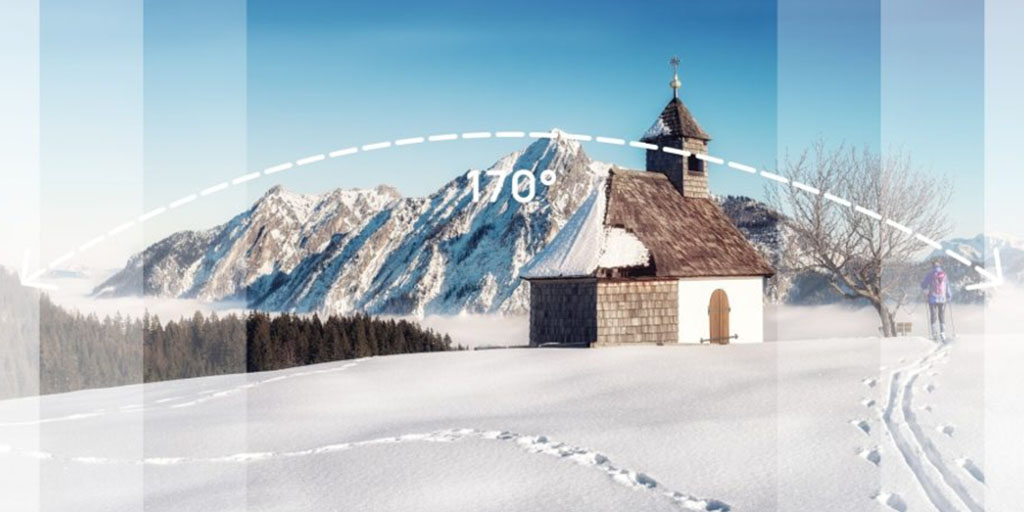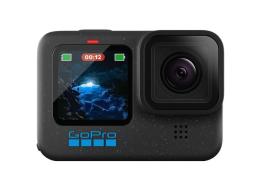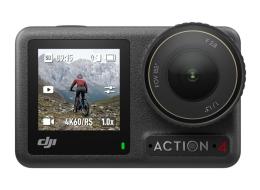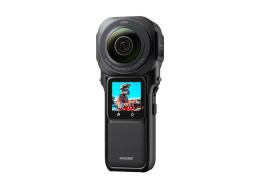Understanding Action Camera Specs: Field of View and Lens Quality


One look at action cam footage and you’ll notice the image is very wide. This wide perspective is quantified by the Field of View (FOV) spec, often given in degrees (e.g. 155°, 170°). It describes how much of the scene is captured, horizontally or diagonally. A 170° FOV is extremely wide – nearly fisheye territory – while a 90° FOV would be relatively narrow (more like a regular phone camera). Action cams traditionally use ultra-wide lenses to capture all the action, hence the name.

An illustration of a wide 170° field of view. Ultra-wide lenses capture a broad panorama (nearly everything in front of the camera), which is great for immersive POV shots. However, straight lines near the edges appear curved due to fisheye lens distortion.
Wide-Angle Lenses
Most action cams have a fixed fisheye or ultra-wide lens. This lets you capture lots of context – imagine skiing downhill: a wide lens shows not just the trail ahead but your arms, the sky, and the peripheral scenery, really putting the viewer “in your shoes.” A 150–170° diagonal FOV is common for the widest setting, which corresponds to roughly a ~14-16mm focal length in full-frame camera terms (very wide).
For example, the DJI Osmo Action 4’s lens is about 155° FOV (focal length ~12mm), and GoPro’s default “Wide” is around 122° horizontal (~16mm). Some cameras or mods push even wider: GoPro’s optional Max Lens mod can reach ~177° for an almost 180° view (at lower resolution).
The trade-off of such wide views is distortion. Fisheye lenses bend straight lines (especially at the frame edges) into curves. You might notice the horizon or buildings bowing in GoPro footage – that’s the price of covering a huge angle. Also, because the view is so wide, subjects appear smaller unless they are very close to the camera (wide FOV “pushes things away”). One effect of a wide FOV is a lower apparent pixel density on distant subjects – you cover a big area with a limited pixel count, so you can’t resolve tiny details far away.
In other words, a wide shot might not show the small text on a sign that a narrow shot could, since the wide image has “more scene per pixel.” Think of it like spreading butter on a large slice of bread – the butter (pixels) is thinner on any given spot.
Lens Quality
Not all lenses are created equal. High-quality action cam lenses use multiple glass elements to reduce aberrations and keep the image sharp from center to edge. Cheaper lenses might be softer (blurry) on the edges or prone to lens flare and color fringing in bright light. The FOV spec doesn’t tell you about sharpness, but reviews often point out if a camera’s lens is especially clear or if it has issues. Distortion can be addressed: many cameras offer a “Linear” mode or distortion correction which crops the image a bit to give a rectilinear (straight-line) look.
For instance, GoPro’s Linear mode (or HorizonLeveling mode) will remove the fisheye warping by using only the center portion of the lens’s view and applying software correction. The result is a narrower FOV (usually around 90–100°) with straight lines. It’s great for when you want a more normal-looking footage (like vlogging, or aerial shots with a horizon). The downside is you lose some of the wide coverage and a few pixels around the edges due to the crop.
Modern cams also sometimes advertise “SuperView” or “HyperView”, which actually use the full tall sensor and dynamically stretch it to an even wider aspect. This yields an extremely wide POV (with intentional distortion) for maximum immersion – great for first-person action but definitely with a fisheye look. Use those for special situations when you want that “GoPro look” of exaggerated perspective.
FOV and Light
Interestingly, wide lenses can affect exposure too. A wide fisheye typically has a smaller effective aperture diameter than a longer focal length lens of the same f-stop, meaning slightly less light might hit the sensor. Also, as one guide notes, “wide-angle lenses are great for action... but in low-light, a wider FOV can result in lower overall brightness”.
This is because the wide lens might be spreading light over a larger sensor area or simply because the scene includes more dark sky or unlit periphery. In practice, if you’re shooting in dim conditions, sometimes using a narrower FOV mode can brighten the image (the camera might digitally zoom to use more of the center of the sensor which could be better exposed). However, the effect is minor compared to sensor size or aperture.
Typical vs. High-End Example
A typical action cam lens might be advertised as “170° super wide-angle.” This likely has noticeable barrel distortion (fisheye effect) at the edges. High-end cams allow flexibility: GoPros and DJIs let you choose wide, linear, or even narrow FOV settings.
For example, the GoPro Hero11 can shoot in Wide (about 122° horiz.), Linear (about 90° horiz., distortion-corrected), or the new HyperView (super stretched wide using the 8:7 sensor). Also, higher-end lenses tend to be sharper. The GoPro Hero10/11’s lens and the DJI Action’s lens are quite crisp for their class, whereas a no-name $50 cam often has edge blurring.
Practice: Check out our action camera index page and try and find two models with complete opposite FOV angle and see how their specs match.
Conclusion
If you want that immersive “everything in frame” look, use the wide/superview modes (and you’ll get the curved horizon). If you prefer a more natural perspective, switch to linear mode if available, accepting a slightly narrower angle.
And remember, you can often correct fisheye distortion in post-processing too – some software has “lens distortion correction” that will straighten lines (essentially doing what Linear mode does, after the fact). Just keep in mind it crops out edges.
The key is that FOV is a creative choice: wide for POV excitement, narrow for detail and realism. Good action cams give you options.
Check out part four of the series where we discuss what's EIS and what is OIS?
Missed part two? Then go back and learn what is frame rate (FPS)?
Featured image by Sanju Pandita.
Different FOV Action Cameras
FAQ
What is Field of View (FOV)?
FOV describes how much of the scene a camera captures, usually in degrees. A wider FOV (like 170°) captures more of the environment, while a narrower FOV (like 90°) offers a tighter, more focused view.
Why do action cameras use wide FOVs?
Wide and ultra-wide lenses (150°–170°) capture immersive, first-person perspectives—ideal for activities like skiing, biking, or surfing. They show more of the surroundings, adding context and energy to the shot.
What’s the downside of a wide FOV?
Wider views often come with fisheye distortion—curved lines at the edges—and can make distant objects appear smaller and less detailed. You also spread the camera’s pixels over a larger area, reducing sharpness on faraway subjects.
Can I fix fisheye distortion?
Yes. Many cameras have a “Linear” or “Horizon Leveling” mode that reduces distortion by cropping and correcting the image. This gives a more natural look but narrows the FOV slightly.
What is “SuperView” or “HyperView”?
These are extra-wide viewing modes that stretch the image for an even more dramatic, immersive effect. Great for POV action, but expect noticeable fisheye curvature.
How does FOV affect image quality in low light?
Wide-angle lenses may gather slightly less light per pixel, especially in dim scenes. Switching to a narrower FOV can sometimes improve brightness, though sensor size and aperture matter more. For more information on low-light performance, check our these action cameras for night-time shooting.
Are all action cam lenses the same quality?
No. High-end cameras like GoPro or DJI use better lenses that stay sharp across the frame. Cheaper models may show softness at the edges, lens flare, or color fringing.
What’s the bottom line on choosing FOV?
Use wide modes for immersive, action-packed shots. Switch to linear or narrow modes when you want a cleaner, more natural-looking image with less distortion. Many cameras let you choose based on your creative needs.



